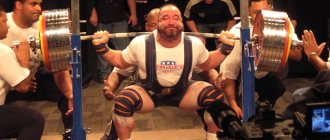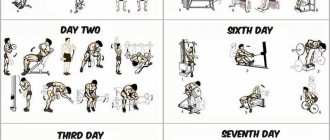March 4, 2020 Admin Home page » Types of sets (approaches) and repetitions
Just starting to engage in strength sports in the form of bodybuilding, powerlifting, fitness, and so on, depending on the purpose of the training, you feel how the body receives a load and acquires a new muscular image, increasing strength endurance and losing the hated fat.
But over time, progress stops, stagnation in development sets in, you seem to be training, trying, eating right and resting, but still you are marking time in one place, and one question is spinning in your head - WHY???
Many people don’t even suspect that the reason lies in the same training weight, repetitions and approaches, training intensity and much more.
Below we will look at progress diagrams, with classes 3 times a week, which allow you to constantly move forward!
For example, we’ll choose the bench press to grow the chest muscles, but you can use it for any muscle area, depending on the part of the body you want to tighten!
Increase reps
The point is to constantly increase repetitions in approaches, with the same working weights , the body experiences stress, a new unusual situation, which involves additional muscle fibers in the work. The main goal is to increase muscle volume!
• Week 1 – 5 sets x 6 reps x 100kg • Week 2 – 5 sets x 7 reps x 100kg. • Week 3 – 5 sets x 8 reps x 100kg.
Pyramid principle
The pyramid in bodybuilding can also be a principle of load progression. There are quite a lot of types, now we are talking about direct (classical), which implies a consistent INCREASE in the weight of the projectile each subsequent approach while simultaneously reducing the number of repetitions. Accordingly, if you correctly adhere to this technique (pyramid), the athlete will be forced to work as hard as possible (as close as possible to the limit of his muscles’ capabilities). More details in the main article: “Pyramid in bodybuilding.”
Ps the principle is similar to regular weight gain (it’s just that the weights are increased in one workout, + the repetitions are decreased). This method is for an advanced level. I do not recommend it for beginners and intermediates.
Increasing approaches
The working approaches gradually increase, the number of repetitions and weight remain unchanged. Before performing, be sure to warm up your muscles - stretching and a warm-up approach with a light weight of approximately 50% of the working weight, thus protecting the ligaments and joints from injury, and the muscles from sprains. The main goal is to increase muscle mass!
• 1 week – 5 sets x 6 reps x 100kg. • Week 2 – 6 sets x 6 reps x 100 kg. • Week 3 – 7 sets x 6 reps x 100kg.
Reducing rest between sets
The essence of the progression can be understood by its name... i.e. The goal is that in each subsequent workout, the rest between sets is shorter (decreased) compared to the previous workout.
For example: on Thursday, you do 30 kg barbell curls for 8 reps. If you want to use this progression of loads, you will need a stopwatch. You did 1 approach, immediately turned on the timer and timed the rest between approaches. Let's say you have a rest of 60 seconds. Okay, we took it and wrote it down in the training diary (mobile phone, notebook, notepad, anywhere, so that you know how much you will need to reduce rest in the next workout in order to progress the load). And so with every approach, in all exercises. Ok, let's say you did 3 approaches and rested for 60 seconds in each.
Further, when you have written down everything and know what and how, in the next workout (already next Thursday) when you do the same barbell lift for biceps 30 kg for 8 times, you will need to rest between approaches no longer for 60 seconds (like that week), and 55 sec.
CONCLUSION: in that workout the rest between sets was 60 seconds, and in this one 55 = progression = growth.
And so on every week, you go down -5 seconds. More than -5 seconds (for example, -10 or -15 seconds each) is not allowed, remember, the progression is important IN PRINCIPLE, not the maximum...
Reduced rest
The main idea is to reduce rest between approaches , thus, muscle areas are more actively involved in the work, their tension and muscle concentration are constantly maintained. Working weights, number of approaches and repetitions remain unchanged. Suitable for military, runners, skiers. The main goal is strength endurance!
• 1 week – 5 sets x 6 reps x 100kg. – rest between approaches 120 seconds. • Week 2 – 5 sets x 6 reps x 100kg. – rest between sets for 100 seconds. • Week 3 – 5 sets x 6 reps x 100kg. – rest between sets 80 seconds.
What is load progression?
As promised earlier, today we begin a dental analysis of the principles of muscle growth. Before us is the first and most important principle - progression of loads. Let's look at what load progression is, why it is used in all sports, and why the principle of load progression is fundamental in bodybuilding.
But first, let's look at one example.
Let's imagine that we have 3 athletes
Vasya, who has just entered the gym, bench presses 20 kilograms for 10 repetitions. Yura, who has been training for 5 years, easily squeezes 180 kilograms for 10 repetitions, while his friend Artem, whose training
The full-time experience is also 5 years, and he benches only 50 kilograms. The newcomer Vasya, the strongman Yura, and the loser Artem are distinguished by only one parameter - the principle of progression of loads. From training to training, Yura increased the weight of the barbell, the number of approaches and repetitions. At each workout, he laid a small “brick” in the foundation of a powerful bench press. Artem had an undisciplined attitude towards training, and therefore often forgot to put a “brick” in his “house”, or even took it out altogether if he was absent from the fitness club for a long time. Vasya, who had just crossed the threshold of the gym, had not yet laid a single “brick”, since he simply did not have the opportunity to do so.
What is load progression? Load progression in bodybuilding is the number of steps you take towards your goal. At the same time, the number of workouts very often does not correspond to the number of steps taken. The vast majority of gym goers mark time day after day, month after month, and year after year. They do not take any steps to achieve their goal, they ignore the principle of progression of loads, and therefore, after years or even decades of regular training in the gym, they do not achieve the goals that can be achieved in a few months of proper training.
Why is the principle of load progression needed in bodybuilding?
Okay, but why can't muscles just grow? Why do we have to take some “steps” towards our goal? The fact is that we misunderstand the very essence of muscle growth. Muscles are just a side effect of proper training. Large muscle mass means high performance, which cannot be achieved without regularly overcoming yourself. Initially, our performance is low. Through training, we step by step increase our body's ability to do more work in 45 to 90 minutes of "pulling the iron." The total amount of weight lifted over a certain period of time increases. This entails an increase in muscle mass.
The progression of loads in bodybuilding is extremely simple: performance increases and muscles grow. Performance does not increase - muscles do not grow. To increase performance, you need to regularly (every 1-5 workouts) add weight, increase the number of approaches or repetitions. It is necessary to increase the number of kilograms lifted per unit of time. This is the progression of loads.
Let's compare the performance of Yura, Artem and Vasya using the bench press as an example
>
| Athlete | Bench Press Barbell Weight | Approaches | Repetitions | Rest between sets in minutes | Total weight lifted (bar weight*repetitions*sets) in kg |
| Yura | 180 | 7 | 10 | 1,5 | 12600 |
| Artem | 50 | 5 | 10 | 2 | 2500 |
| Vasya | 20 | 4 | 10 | 3 | 800 |
The difference between Yura and Artem is 5 times. The difference between Yura and Vasya is 15.75 times. The differences are simply colossal. And all this using the example of one bench press. If you break down the entire workout, the numbers become much more impressive. Example of load progression
This is approximately how a beginner needs to “step” so that the progression of loads gives maximum growth in muscle mass:
Workout #1
| Exercise | Weight | Approaches | Repetitions | Rest in minutes | Work completed (total weight) |
| Bench press | 20 | 4 | 10 | 3 | 800 |
Workout #2
| Exercise | Weight | Approaches | Repetitions | Rest in minutes | Work completed (total weight) |
| Bench press | 20 | 5 | 10 | 3 | 1000 |
Workout #3
| Exercise | Weight | Approaches | Repetitions | Rest in minutes | Work completed (total weight) |
| Bench press | 20 | 6 | 10 | 3 | 1200 |
Workout #5
| Exercise | Weight | Approaches | Repetitions | Rest in minutes | Work completed (total weight) |
| Bench press | 20 | 7 | 10 | 3 | 1400 |
Workout #7
| Exercise | Weight | Approaches | Repetitions | Rest in minutes | Work completed (total weight) |
| Bench press | 25 | 5 | 10 | 3 | 1250 |
Workout #9
| Exercise | Weight | Approaches | Repetitions | Rest in minutes | Work completed (total weight) |
| Bench press | 25 | 5 | 10 | 2,5 | 1250 |
Workout #20
| Exercise | Weight | Approaches | Repetitions | Rest in minutes | Work completed (total weight) |
| Bench press | 30 | 5 | 10 | 2,5 | 1500 |
Workout #50
| Exercise | Weight | Approaches | Repetitions | Rest in minutes | Work completed (total weight) |
| Bench press | 50 | 5 | 10 | 2,5 | 2500 |
Workout #100
| Exercise | Weight | Approaches | Repetitions | Rest in minutes | Work completed (total weight) |
| Bench press | 75 | 5 | 10 | 2,5 | 3750 |
After 100 classes, a beginner who at the start had no muscle mass at all
piss, increased the bench press from 20 to 75 kilograms, reducing the rest between sets by 30 seconds. The volume of work performed increased from 800 to 3750 kilograms. And since performance has increased (the athlete performs 4.7 times more work in less time), then there are significantly more muscles.
Share link:
- Click to share on Twitter (Opens in new window)
- Click here to share content on Facebook. (Opens in a new window)
Similar
Combined scheme
To achieve better results, use a combination of all 4 schemes, many athletes use this in their professional activities, which brings them results, but why are you worse???
1. Increase in strength and muscle mass - more suitable for strength athletes, for whom strength and muscle volume come first. To do this, combine schemes: increasing approaches and speed!
2. Increasing muscle volume is a difficult combination, but it allows you to work productively on muscle development. To do this, use and constantly swap schemes: increase repetitions and approaches!
3. Fat reduction and muscle growth - the fastest way to achieve an excellent result in creating a beautiful, sculpted, muscular body is by combining schemes: reducing rest and increasing approaches!
4. Reducing fat and increasing strength - great for those who want to reduce body fat while increasing strength. Super method for sprinters. Achieve this without problems using schemes: increasing speed and reducing rest!
How to enter into a weekly plan?
The rules for introducing such classes depend on what program the athlete is engaged in.
- Circuit training is widely used to increase endurance and strength. The bottom line is that throughout the week the athlete performs the same exercises, usually working only one muscle group. In this case, on Monday there is heavy training with maximum weight, on Wednesday light training, and on Friday the plan of the first day is completely repeated.
- The standard training plan involves loading different muscle groups on different days. For example, on Monday the legs are worked out, on Wednesday – the back, on Friday – the chest and arms. In such cases, the plan is modified as follows: Monday - hard, Wednesday - easy, Friday - hard, Monday - easy, etc. The plan is designed for two weeks, as a result, over 14 days, each group being worked on trains intensively once, and lightly the second time.
- Another scheme is alternating heavy, medium and light loads. It can be fit into absolutely any training plan.
In general, there is no universal method for periodizing loads. There are a lot of them, and many athletes develop their own scheme, thanks to which they manage to exercise comfortably, but at the same time maintain constant progress.
https://youtu.be/TFQ4rMMRpXk
Concentric and eccentric phase of the exercise
In strength training aimed at developing hypertrophy, the eccentric and concentric phases of repetitions are equally important. The meta-analysis, which looked at studies where participants had to do either concentric or eccentric strength training alone, found that concentric-only strength training alone resulted in an average gain of 6.8 percent in muscle mass, and eccentric-only strength training resulted in an average gain of 6.8 percent. The difference between the effectiveness of each type of strength training is borderline significant—and therefore not entirely statistically significant.
Purely concentric strength training means that you only use your muscles to lift the weight and lower it back down without any resistance. Exclusively eccentric strength training is the opposite of this. An assistant or special device lifts the weight for you, and you only use your muscles to lower the weight in a controlled manner. In reality, bodybuilding exercises are always performed in both phases, but at different speeds. If in the concentric phase acceleration (and not inertia) is the way to increase the load, then quickly lowering the projectile in the eccentric phase leads to a decrease in the load on the muscles. For this reason, to get the most out of both phases, exercises should be performed focusing not only on lifting the apparatus, but also on lowering it. There is no need to purposefully extend the eccentric phase over time (although this is not prohibited), but the lowering must be controlled. This will already be enough.
After a long break
After a forced break in training, we recommend doing 2 sets instead of 3 or 4. And taking the weights 50% of those you used when you were still training. Yes, after training your muscles will ache. Strongly. But not so much that you fall behind schedule for a week.
In the future, you will gradually return to your working weights and begin to progress. Start small and increase the weight in each approach: for a barbell - by 10 kg, for dumbbells - by 2. You definitely won’t miss!
Bench press example
Warm up: empty bar, 20 reps. We weigh 10 kg and do a set. We hang another 10 and work. And so we reach 60 kg. If it becomes difficult in some approach, then there is no need to increase the weight in this workout. In the future, when it becomes difficult, add 1-2 kg and look at the result.
Working weight[edit | edit code]
httpv://www.youtube.com/watch?v=embed/XpRTBHe3jzs?
Denis Borisov. How to choose a working weight
Working weight
- a concept in bodybuilding that characterizes the weight of the equipment with which the exercise is performed. The working weight determines the intensity of the workout and also depends on the goals: strength, muscle growth, endurance, speed, etc.
Depending on the working weight there are:
- Low intensity training - 10-40%RM
- Moderate intensity workouts - 40-80%RM
- High intensity training - 80-100%RM.
Abbreviations: 1RM
(1 maximum repetition) or
1RM
- one repeated maximum. 8RM means that the working weight is selected with which you can perform a maximum of 8 repetitions.
Percentages of the repeated maximum are also used and light weights are conditionally distinguished: 10-40%RM, medium weights 40-80%RM, heavy weights 80-100%RM.
Read more:
Training intensity
How to calculate working weightedit | edit code
As a rule, in bodybuilding they use 6-8 repetitions in each approach, this is the optimal number. Therefore, select a weight that you can lift 8 times, provided that the last repetition is a failure, first perform a warm-up weight with 50% of the expected working weight. The resulting figure will be the working weight. Remember that for 20% extra repetitions in trial sets, you need to increase the weight by 10%.
However, it should be noted that if you select the weight after several attempts, the final result will be lower, since the muscles will already be fatigued.
There is another less accurate method that allows you to determine your working weight.
:
Use a special calculator: https://fatalenergy.com.ru/calculators/
Calculation example:
1. You assumed that in a trial approach you can lift a 70 kg barbell 10 times. 2. Do 1 set of 7 reps with 35kg. (Warm-up set) 3. Lift the barbell as many times as possible. Let's say you got 12. 4. You lifted 20% more times than expected, which means the weight needs to be increased by 10% 5. Your approximate working weight is 77 kg. Check it out in your next workout and make adjustments.
Third method: progression in rest
In this case, the main task is to reduce the rest time between sets. The weights used during training remain the same. The main advantage of this method is reducing the duration of your training and increasing strength endurance, which is especially important for athletes and military personnel. The training schedule looks like this:
- First week – 5 sets and 5 repetitions, rest between sets 75 seconds.
- Second week - 5 sets and 5 repetitions, rest between sets 70 seconds.
- Third week – 5 sets and 5 repetitions, rest between sets 65 seconds.
Training large muscles together with small ones
Small muscle groups need to be trained together with large ones. This way, greater progress will be achieved.
This misconception was based on a previously existing theory about the connection between changes in the levels of anabolic hormones in response to physical activity and subsequent progress. Since training large muscle groups caused large hormonal changes, it was hypothesized that training small muscle groups in isolation from large muscle groups was ineffective due to little hormonal stimulation. Therefore, it is better to combine them in one workout so that the small muscles are exposed to more hormones circulating in the blood. This theory has never been confirmed and has been refuted by many studies. No connection has been established between hormonal changes during exercise and subsequent muscle growth. Large and small muscle groups progress well, both with joint and separate training. The main criterion for muscle growth is adequate physical activity and subsequent recovery, and not short-term surges of endogenous hormones.
Speed increase
The main goal is to perform sets at a faster pace than last time. Working weights, sets and repetitions, as well as rest time between sets remain the same. Ideal for those who need periodic explosive accelerations for a few seconds - football players, basketball players, tennis players, etc. The main goal is muscle endurance, the ability of muscles to work longer!
• 1 week – 5 sets x 6 reps x 100kg. – approach time 10 sec.• 1 week – 5 sets x 6 reps x 100kg. – approach time 9 sec.• 1 week – 5 sets x 6 reps x 100kg. – approach time 8 seconds.
Working weight for advanced
At an advanced stage of training, athletes begin to use various methods of creating the necessary stress to trigger the synthesis of contractile proteins, but all of this, one way or another, is a way to progress the load. The most effective way to progress the load is to increase the working weight, but when you bench press 200 kg, increasing it even by 1-2 kg is already a problem, so athletes resort to various tricks. It is most effective to try to increase the intensity of the training by reducing the rest time between approaches. But this method is very limited, so it is used, as a rule, in conjunction with reducing working weight. Thus, the athlete performs exercises with lighter weights, but his CP increases significantly. If earlier the number of barbell lifts per workout was, say, 100, with a weight of 200 kg, now the KPSh is 200 with a weight of 150 kg.
But, despite the increase in total tonnage, this method is rarely used, and only a few are used correctly, since it’s easier to overtrain in this way! The most commonly used are cheating, supersets, complex sets and forced repetitions. There is no need to talk about what it is, how to apply it, that the load on the target muscle group should increase and not decrease, because if you are an advanced athlete, you already know all this
What is important? It is important to determine whether “super moves” are a system of progressive load, or simply a way to create additional stress on the muscles. If this is a system, then the working weight must be gradually progressed, but if this is a way to create unusual stress, then you can only rely on your feelings
And precisely because in order to use “super techniques” an athlete must have good muscle sense, understand his body well, be able to empirically select the working weight and load volume, the use of “super techniques” is not recommended. Try to progress for as long as possible using the simplest methods, and only when this is completely impossible, start using “super techniques”
It is also important to note that many of these techniques can only be used if the athlete is using anabolic steroids. For example, it is better not to use complex sets and forced repetitions as a natural
For experienced athletes who avoid pharmacology, it is permissible to use supersets and cheating in their training.
A very common question comes up, especially from girls: “how to determine the working weight in exercises?” There is nothing surprising in this; it is often difficult for beginners to adequately assess their capabilities.
And if, for example, when working with exercise machines it is not so scary to choose the wrong weight, then when working with free weights such as deadlifts, squats or bench presses, the wrong weight can cause injury, physical and mental.
How to choose the right working weights for training, or rather, exercises? How do you know that you won't suffocate under the weight of the barbell? What weights can a girl target?










